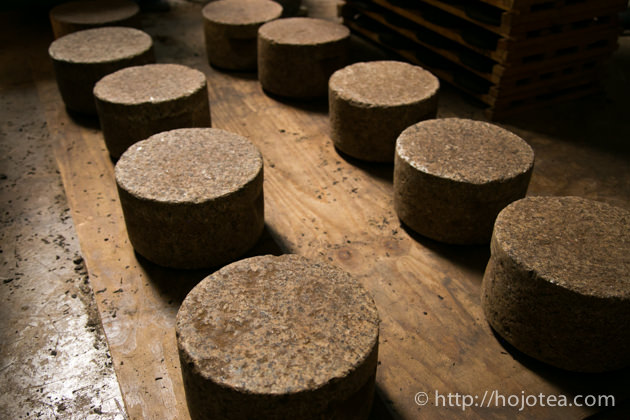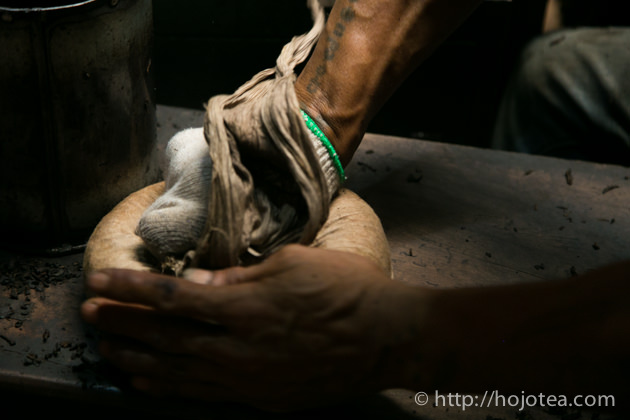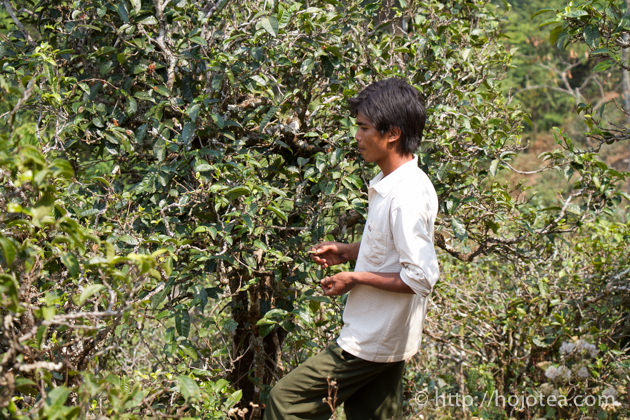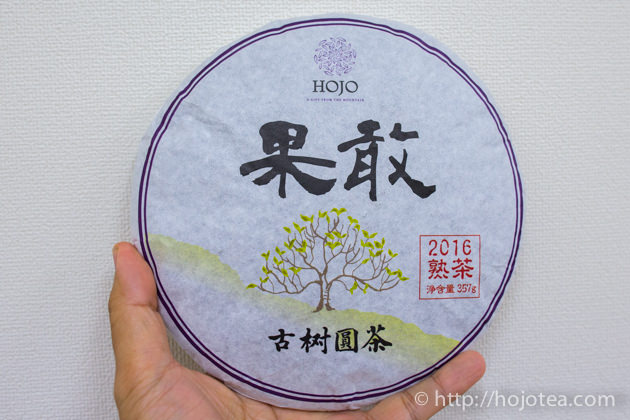- HOME >
- New Arrival at HOJO Online Shop
New Release of Guo Gan Ripe Pu-erh from Myanmar
- [2017.11.14] Posted By Akira Hojo

We released ripe pu-erh tea produced in Myanmar from the area called Guo Gan. This is very limited and rare kinds of tea. We purchased the mao-cha produced in 2016 and compressed it into 357g cake. Although tea was produced just a year ago, it is quite nice to drink it even now. Nevertheless, if we store this tea for another few years, it will develop more fruity and sweet flavor.


Tea was collected in Myanmar near the Yunnan border
In Myanmar, Guo Gan is located next to the South West Yunnan. The population of Guo Gan consists of a number of Chinese minorities. In the town of Guo Gan, many people speak Chinese and many sign boards are written in Chinese. The Guo Gan autonomous region has very strong economic linkage with Yunnan. In particular, pu-erh tea is a very important trading item for them.
In the history, there were always civil wars taking place in Guo Gan due to the conflicts between different tribes. In the past few years, they have had very severe fights and many fighter aircrafts and fire shells of trench mortar were often going around. In 2016, they have temporarily ceased the war, although a number of conflict zones are still remained.

The village of Myanmar that is just a few houses away from the national border to China. In 2013, we visited there before the civil war begun.
Primary process in Myanmar and fermentation in Yunnan
Since the conflict zones are still in great danger, the China immigration department does not allow Chinese to travel to Guo Gan at the moment.
Our tea was produced in 2016. The tea leaves were transported by farmers of Myanmar to Yunnan. They drove a track all the way to Yunnan to supply the mao-cha of raw pu-erh tea. Those farmers are the apprentices of the Yunnan pu-erh tea manufacturer. Before 2014, while Guo Gan was still in peace, the Yunnan tea manufacturer set up the factory in Guo Gan, and these farmers learned the skills of producing pu-erh tea from the Yunnan tea master.
For now, even though there is no Chinese stationed in Guo Gan, the farmers have skills to process tea. As such, the Guo Gan ripe pu-erh tea is made in the collaboration between the people of two countries.
Tea is grown without fertilizer and pesticide
Even in Yunnan province, Guo Gan ripe pu-erh tea is very rare and limited. It is because of most of the Guo Gan teas are purchased by specific people on the spot. Some people are aware of the quality of Guo Gan ripe pu-erh tea. Since the total production is not really a lot, most of Guo Gan ripe pu-erh teas are bought right at the primary processing plant.
In the past few years, the price of Guo Gan ripe pu-erh tea has been gradually increased. However, some Guo Gan tea gives astringent taste and light after taste if it is sourced from the garden near the villages. Since we are highly aware of this issue, we look for the tea that gives long lasting after taste, clear drinking sensation and rich mouth-feel.
Right now our Guo Gan 2016 ripe pu-erh tea is about one year old. It gives comfortable body with sweetish drinking sensation. However, its quality will be even greater after it is aged for a year or two.





The oxygen management affects the flavor of ripe pu-erh tea
Some people mentioned that they do not like to drink ripe pu-erh tea. It is mostly due to the prejudice that they think ripe pu-erh tea gives the odor like rotten wood, earthy, musty or moldy. I believe that the perception of the unpleasant odor is kind of defensive response that our body is trying avoid the intake of food that is not suitable for our health.
The ripe pu-erh tea undergoes the microbiological fermentation spending more than a month. During the fermentation, it is very critical to control the moisture content of the piled tea. The tea has to be agitated frequently in order to supply adequate oxygen. If too much moisture is applied or the manufacturer neglects the agitation, the oxygen inside the piled tea leaves is insufficient. As a result, the anaerobic bacteria (bacteria that does not require oxygen) dominate and it typically produces very unpleasant odor that is mentioned earlier.
In fact, many kinds of anaerobic bacteria are known to produce some toxins as well. If the tea fermentation process is well-managed with the adequate level of moisture and oxygen, the ideal fermentation is taken place by aerobic bacteria, mainly actinomyces and it produces sweet and dry-fruity flavor.
When we select ripe pu-erh tea, we care not only the base quality of tea but also how the fermentation is carried out.
As the Guo Gan Ripe Pu-erh tea was typically well-managed in fermentation, it gives no earthy or musty odor. It has mild sweet and dry-fruity flavor and with a little woodsy note.
If this tea is kept for a few more years, the flavor will be amplified, the lingering sweetness will increased, the taste gets clearer and the mouth-feel will be softer.
Related Articles
How to get the latest update on HOJO Tea?
1. Follow Twitter, 2. Click "Like" on Facebook, and 3. Subscribe in newsletter. You can have the latest tea news from HOJO Tea.
 Subscribe the Newsletter to enjoy the privileges
Subscribe the Newsletter to enjoy the privileges- You may receive a free sample upon purchase, or you may have the priority to purchase special products. So please remember to subscribe our newsletter as well as the social network.
- New Release of High Mountain White Tea
- We are pleased to introduce our High Mountain White Tea, sourced from a unique tea garden with two key features: 1. Located at an altitude of 2200-2300m2. Completely wild and untended The ideal natural conditions of this garden result in tea of exceptional quality, offering a pure and gentle, nourishing taste. High Altitude and Wild …
- New Release of Da Xue Shan Wild White Tea 2024
- We have released the 2024 Da Xue Shan Wild White Tea Loose Leaf. This tea was produced under our direct supervision during our stay in Yunnan Province, ensuring meticulous production management on site. Definition of Wild Tea in Yunnan Province People in Yunnan strongly associate Camellia taliensis with wild tea, regardless of where it is …
NEW ARTICLES
 Why Do Some Teas Taste Astringent? Exploring the Causes and Mechanisms of Astringency
Why Do Some Teas Taste Astringent? Exploring the Causes and Mechanisms of Astringency- Tea can range from having no noticeable astringency to possessing a very strong one. What causes this astringency? This article explores the causes and mechanisms behind astringency in tea. Causes of Astringency Astringency arises from the binding of tea components to proteins in the oral cavity, creating a sensation of tightness or dryness. The tongue …
 The Impact of Heat Sources on Tea Flavor
The Impact of Heat Sources on Tea Flavor- It is widely recognized that the material of a kettle plays an important role in shaping the taste of water for brewing tea. Yet, an often overlooked but equally significant factor is the type of heat source used to boil the water. Different heat sources, whether gas, electric, charcoal, or wood fire, can impart distinct …
 New Release of High Mountain White Tea
New Release of High Mountain White Tea- We are pleased to introduce our High Mountain White Tea, sourced from a unique tea garden with two key features: 1. Located at an altitude of 2200-2300m2. Completely wild and untended The ideal natural conditions of this garden result in tea of exceptional quality, offering a pure and gentle, nourishing taste. High Altitude and Wild …
 New Release of Da Xue Shan Wild White Tea 2024
New Release of Da Xue Shan Wild White Tea 2024- We have released the 2024 Da Xue Shan Wild White Tea Loose Leaf. This tea was produced under our direct supervision during our stay in Yunnan Province, ensuring meticulous production management on site. Definition of Wild Tea in Yunnan Province People in Yunnan strongly associate Camellia taliensis with wild tea, regardless of where it is …
 New Release of Wild Pu-erh Jasmine Pearl
New Release of Wild Pu-erh Jasmine Pearl- Out of curiosity, we decided to create a jasmine tea based on Da Xue Shan Wild Raw Tea. This resulted in an exceptionally rare tea, not only in Japan but also in China. Custom Production Network for Jasmine Tea At our store, we source various types of base teas from different regions during the spring. …
 2024 Overview: Our Yunnan White Tea Quality, Process, and Weather Insights
2024 Overview: Our Yunnan White Tea Quality, Process, and Weather Insights- One of the teas we’ve been focusing on in Yunnan Province is white tea. Historically white tea has been produced in both Fujian Province and Yunnan Province for a long time. While white tea from Fujian Province is well-managed during processing, we are dissatisfied with the quality of the raw materials due to the use …
 Yunnan’s Hospitality Culture: Expressed Through Meals
Yunnan’s Hospitality Culture: Expressed Through Meals- In China, as a form of greeting, it’s common to say “你吃饭了吗?” which means “Have you eaten?” However, in Yunnan Province, the phrase “吃饭” is often used in various situations, more like “Eat, eat,” serving as an invitation to share a meal. Yet, with prolonged exposure to Yunnan, one comes to understand that these meal …
 In Search of Wild Tea: Exploring Mountain Villages in Southwest Lincang, Yunnan
In Search of Wild Tea: Exploring Mountain Villages in Southwest Lincang, Yunnan- We are currently sourcing tea in the southwestern part of Lincang City, Yunnan Province. One of the crucial products for us is wild tea. While tea processing is important, securing the raw materials poses the biggest challenge. Recently, we received information about a new location where wild tea supposedly grows. To verify this, we visited …
 New Release of Anxi Traditional Oolong
New Release of Anxi Traditional Oolong- Anxi, located in Fujian province, China, is celebrated for its Tie Guan Yin tea. However, the Traditional Anxi Oolong from this region boasts a unique fruity aroma, distinguishing it from Tie Guan Yin. Anxi: A Renowned Hub for Oolong Tea Production in China Fujian Province, renowned for its rich tea heritage, boasts several prominent tea-producing …
 Yunnan 2024 Spring Tea Sourcing
Yunnan 2024 Spring Tea Sourcing- Yunnan Province is globally renowned for the exceptional quality of its tea leaves. However, lax production management often presents challenges in achieving the desired tea quality when relying solely on pre-made teas. To address this issue, we have committed to remaining on-site throughout the spring season to closely monitor tea production. We are meticulously inspecting …
Shop Info

Address:Lot No. T-215, 3rd Floor, The Gardens Mall, Mid Valley City, Lingkaran Syed Putra, 59200 Kuala Lumpur
Tel: +603-2287-4537
Business Hour: 10am to 10pm
Category
- New Arrival at HOJO Online Shop
- Featured Articles
- Newsletter
- Types of Tea
- Origin of Tea
- Teapot and Tea Equipment
- Tea Column
- How to enjoy tea
- Tea Processing
- How to choose quality tea
- Tea constituents and functional effect
- Safety of Tea
- Foods
- Tea Business Operation
- Hobby and Outdoor Activity
- Ranking of Tea
- Video
- FAQ
- Media Release
Profile

- AKIRA HOJO
- I invite you to experience my tea selections.I was born in Nagano, Japan. In university, I studied agricultural chemistry, and I have the master degree in food science. I worked in Japanese food industry for 10 years. I involved in R&D, QC and QA. As a factory manager, I implemented ISO9000 series and managed the factory.
- The Art of Tea Magazine
- We posted the article on “The Art of Tea Magazine No.9, the magazine is published in Taiwan. We featured some scientific view about the tetsubin
- New Straits Times
- The Malaysian National Newspaper, New Straits Times featured HOJO Tea on 17-Oct-2007.





















